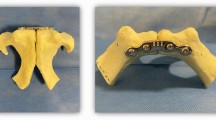Summary
For the stabilization of the ruptured pubic symphysis, rigid forms of fixation such as plate osteosynthesis and flexible fixations such as wire loops or PDS banding have been recommended. All methods have only been tested by static unidirectional loading until failure of the system. By this experimental arrangement Ecke and Hofmann found comparable results for flexible and rigid methods of internal stabilization of the pubic symphysis. They preferred flexible methods to maintain mobility of the symphysis and to prevent symphyseal fusion. We tested dynamic compression plate osteosynthesis, reconstruction plate osteosynthesis, wire loops and PDS banding for internal fixation of injured pubic symphysis in a dynamic multidirectional experimental arrangement simulating gait conditions. The specimens were loaded with 85 N in vertical (y -) direction and 34 N in sagittal (z -) direction, which represent 50 % of the forces acting at the pubic symphysis during walking and with a frequency of 1.5 Hz over 55 500 loads simulating the conditions over a 6-week mobilization period. Loading with 100 % of the acting forces (corresponding to full weight bearing mobilization) led to early failure of the system. Our experimental analysis showed that neither wire loops nor PDS banding is able to stabilize the ruptured pubic symphysis, even immediately after fixation before loading. During the tests instability increased until failure of the system due to cutting of the bone or breaking of the wires or PDS banding. Success of plate osteosynthesis was dependent on the initial stability of the fixation. Overwinding of the screws, as in osteoporotic bone, lead to increasing loosening during repeated loading, whereas primary stable fixation of the screws was almost completely maintained during the test. In consequence, neither wire loops nor PDS banding should be used for stabilization of injured pubic symphysis if early mobilization with partial weight bearing is desired. Plate osteosynthesis (DC or reconstruction plate) tolerates early half weight bearing in patients with „open-book“ injury only if safe screw fixation is guaranteed.
Zusammenfassung
Zur Stabilisierung rupturierter Symphysen wurden „rigide“ Fixationen (Plattenosteosynthesen) und flexible Fixationen (Drahtzuggurtungen, PDS-Bandings) angewandt. Für beide Verfahren waren experimentell bisher nur statische unidirektionale Zugbelastungsprüfungen durchgeführt worden. Ecke und Hofmann kamen so zu dem Ergebnis, daß mit flexiblen Fixationen gegenüber rigiden Verfahren eine vergleichbare Stabilität zu erzielen sei und diese wegen der Erhaltung der Beweglichkeit in der Symphyse zur Prophylaxe deren Ankylosierung zu präferieren sei. Durch simultan-multidirektionale dynamische experimentelle Untersuchung unter Gangsimulationsbedingungen wurden Symphysenstabilisierungen mittels DC-Platten, Rekonstruktionsplatten, Drahtzuggurtungen und PDS-Bandings vergleichend getestet. Die Symphysenpräparate wurden in Sagittal- und Vertikalrichtung synchron mit einer Frequenz von 1,5 Hz über 55 500 Lastwechsel (Schritte während 6 Wochen Mobilisation) belastet. Die Belastung erfolgte mit der Hälfte der in einer früheren Untersuchung für den Gang ermittelten mittleren Kräfte, nachdem sich bei einer Vollbelastung keine Fixationsmethode als ausreichend stabil erwies. Weder die Drahtzuggurtung, noch das PDS-Banding waren ausreichend stabil, wobei diese Verfahren bereits unmittelbar nach Versuchsbeginn eine über die physiologischen Grenzen reichende Symphysenmobilität zuließen. Im weiteren Versuchsverlauf verstärkte sich die Instabilität durch Einschneiden der Cerclagen und Bandings in den Knochen oder Bruch der Drahtcerclagen generell bis zum völligen Versagen. Bei den DC-Platten- und Rekonstruktionsplattenstabilisierungen dagegen war der Stabilisierungserfolg abhängig von der primären Stabilität der Schraubenverankerung. Bei primärer Überdrehneigung der Schrauben wurde die Plattenstabilisierung unter dynamischer Belastung immer instabiler. Bei primär stabiler Verankerung der Plattenschrauben blieb die Fixation in vollem Umfang über 55 500 Lastwechsel mit einer Belastung entsprechend dem durchschnittlich halben Körpergewicht stabil. Für die klinische Anwendung läßt sich aus diesen Ergebnissen ableiten, daß weder die Überbrückungszuggurtung mit Drahtcerclagen, noch das PDS-Banding die rupturierte Symphyse ausreichend für eine frühzeitige postoperative Mobilisierung unter Teilbelastung stabilisieren. Kann mit der DC-Platte oder der Rekonstruktionsplatte primär eine sichere Stabilisierung der rupturierten Symphyse durch gute Verankerung der Schrauben im nicht osteoporotischen Knochen erreicht werden, kann der Verletzte mit „Open-book-Verletzung“ mit Teilbelastung entsprechend dem halben Körpergewicht mobilisiert werden.
Similar content being viewed by others
Author information
Authors and Affiliations
Rights and permissions
About this article
Cite this article
Meißner, A., Fell, M., Wilk, R. et al. Comparison of different methods of internal fixation of symphyseal disruptions under multidirectional dynamic conditions: an experimental analysis simulating gait conditions. Unfallchirurg 101, 18–25 (1998). https://doi.org/10.1007/s001130050227
Published:
Issue Date:
DOI: https://doi.org/10.1007/s001130050227




